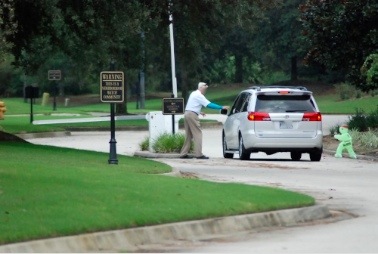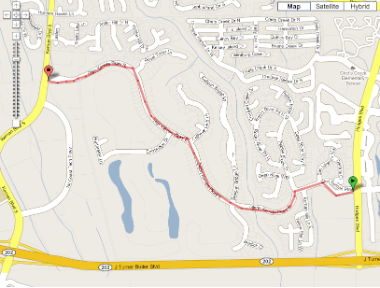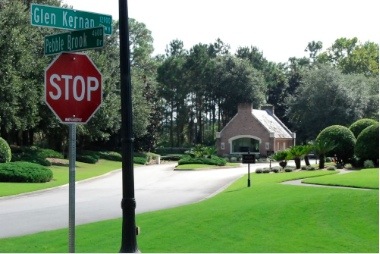 Even before Florida was a state the movement of people and goods was a concern to those in power. With the public highways of the early to mid 1800's not land based but being the waterways of this great state. The leaders at the time of Florida's statehood in 1845 thought the protection of those right-a-ways so important that they created the The Public Trust Doctrine: Protection of Navigable Waters.
Even before Florida was a state the movement of people and goods was a concern to those in power. With the public highways of the early to mid 1800's not land based but being the waterways of this great state. The leaders at the time of Florida's statehood in 1845 thought the protection of those right-a-ways so important that they created the The Public Trust Doctrine: Protection of Navigable Waters.
What is Navigable Waters?
As applied in Florida, the Public Trust Doctrine protects water bodies that were navigable in fact at the time of statehood in 1845. In 1909, the Florida Supreme Court defined the term "navigable in fact" as meaning "navigable for useful purposes common to the public in the locality where the waterbody is located."
The term "navigable for useful purposes" must be understood in the context of the transportation system that actually existed at the time of statehood. In 1845, the only railroad in the state ran from Tallahassee to St. Marks, and operated on wooden rails with carts pulled by mules. Engines didn't arrive until eleven years later. The status of land transportation routes is evidenced by two provisions in an early act of the territorial legislature. The first provision declared that a public road was in satisfactory condition so long as the tree stumps left in the road were less than 12 inches high. The second provision declared that bridges and causeways used in connection with these roads could remain out of repair for as long as 15 days unless repair was "hindered by extremely bad weather," in which case the bridges could be out for even longer. As a result, lakes and streams were by far the most reliable public highways for moving goods and people. An early congressional act recognized the public status of these highways when it declared that all the "navigable rivers and waters in the districts of East and West Florida shall be, and forever remain, public highways."
That was then, this is now.
City and state leaders are still concerned with the protection of the right-a-ways for the movement of people and goods on our roads and highways. As long as you're doing that movement by automobile. If you chose any other source of transportation, like say a bicycle, your options for travel are most likely not the most direct or safest choice. Oh sure, the state says you as a cyclist have access and a right to all roads. But are those roads available the best and safest options for you? What if there is a shorter safer road that lies between you and your destination but you are restricted from using it for one reason or another. Would you still use it?
Meet Glen Kernan Parkway.
 By looking at a map you would think that Glen Kernan Parkway would be an ideal link between Hodges Blvd. and Kernan Blvd.. But you would be in for a surprise once you made it there by bike. Especially if you entered Glen Kernan from Hodges Blvd.
By looking at a map you would think that Glen Kernan Parkway would be an ideal link between Hodges Blvd. and Kernan Blvd.. But you would be in for a surprise once you made it there by bike. Especially if you entered Glen Kernan from Hodges Blvd.
The problem is Glen Kernan Parkway turns out to be a private road...Partly. If you turn on to Glen Kernan Pkwy from Hodges Blvd. It is a public road for the first quarter mile. Upon which you run into the gates of doom.
 So why are commuters risking arrest for trespassing rather than finding another route? If you look at the map above you'll see that Glen Kernan is the only roadway that connects the two major roadways of Kernan Blvd. & Hodges Blvd.. The only other option for those along Hodges Blvd. is to ride the unmarked shoulder of a posted 45 mph road with actual speeds in the neighborhood of 55 mph. to the two-lane Hunt Club Rd. with 45 mph speeds and no bike lanes or unpaved shoulders to Beach Blvd. and then back up Kernan Blvd. A distance just under 5 miles.
So why are commuters risking arrest for trespassing rather than finding another route? If you look at the map above you'll see that Glen Kernan is the only roadway that connects the two major roadways of Kernan Blvd. & Hodges Blvd.. The only other option for those along Hodges Blvd. is to ride the unmarked shoulder of a posted 45 mph road with actual speeds in the neighborhood of 55 mph. to the two-lane Hunt Club Rd. with 45 mph speeds and no bike lanes or unpaved shoulders to Beach Blvd. and then back up Kernan Blvd. A distance just under 5 miles.
Why the need to get to Kernan Blvd. from Hodges Blvd. so great? Lets look at another map.
 The strife over access to Glen Kernan Pkwy. has only risen in the last year with the opening of the Kernan Multi-use path that runs from Atlantic Blvd on the North End to just past the entrance of Glen Kernan Pkwy. it seems that as more people become aware of the bike path, they prefer using it over the shoulder of a road with cars whizzing by at 55 mph. It's also helpful to point out that Jacksonville's largest University, the University of North Florida is also just off the Kernan Blvd. Bike Path at the south end. And at the Kernan Blvd. & Beach Blvd. intersections you have all your major retailers which also contribute to make the bike path a more appealing choice of travel.
The strife over access to Glen Kernan Pkwy. has only risen in the last year with the opening of the Kernan Multi-use path that runs from Atlantic Blvd on the North End to just past the entrance of Glen Kernan Pkwy. it seems that as more people become aware of the bike path, they prefer using it over the shoulder of a road with cars whizzing by at 55 mph. It's also helpful to point out that Jacksonville's largest University, the University of North Florida is also just off the Kernan Blvd. Bike Path at the south end. And at the Kernan Blvd. & Beach Blvd. intersections you have all your major retailers which also contribute to make the bike path a more appealing choice of travel.
So what's the problem? Well it turns out that residents of Glen Kernan are not happy with cyclist who use their private road as a cut thru between the two major roads. Cyclist are repeatedly threatened with arrest by Glen Kernan's private security force. But as of yet, I've not heard of anyone being arrested or charged by Glen Kernan.
Which brings us full circle to laws pertaining to navigable waterways. People are just like bodies of water, in that they will always take the path of least resistance to get from point a to point b.
I'm not saying that residents of Glen Kernan should have to open the road to everyone. Not all roads are open to bicycles, why should every road be open to the automobiles of the general public? But a few cyclists traveling quietly thru their neighborhood should pose no problem for them. I also believe that the needs of a community on the whole out weigh those of few select individuals. What I'm suggesting is that Navigable Roadways whether public or private should be navigable for useful purposes common to the public in the locality where the roadway is located. The founders of our state understood this principal. It's time we relearned it.


6 comments:
Thank you for this post! My life would be a lot easier at times if I could utilize Glen Kernan Pkwy.
Rebekah, My best suggestion is call, write, and/or email your council person and make them aware of the problem. The squeaky wheel gets the attention.
The only problem with this argument is this road is paid for privately. It just happens to connect two major roads.
From riding a bicycle in surrounding neighborhoods, I understand the pain in circumventing areas on a bicycle. It makes one travel several miles out of ones way. For people in cars, it is only a few more minutes of pressing the accelerator, brake and steering the wheel. For people on bicycles, it is sometimes up to 30 mins of pedaling on unwelcome roads, through busy intersections on multi lane traffic in the sun and heat using personal stamina.
Directness in a route is of utmost importance when making bicycling favorable in a city. Read article on directness here: link
Bicycle will continue to be an inferior mode of transportation for people living on Hodges Blvd. or for people trying to get to Hodges Blvd. as long as Glen Kernan keeps its gates shut.
As much as I'd love for the private road to be accessible to bicyclists as well, for safety for us, I'm going to play a little devil's advocate.
If we strive to be recognized as motor vehicles, (following traffic signals, signs, riding the same direction of traffic flow, lights and safety equipment after dark, etc.), and we wouldn't be allowed to use the neighborhood for a shortcut if we were in our personal motorized vehicles, why should we be allowed to access through private property by bicycle? If we can't drive through by car, then what gives us the right to ride through with our bicycles if we can't be there rightfully? The security are probably just doing their job, and I can't speak on "how" they do it because I've never passed through.
How are we supposed to get any kind of respect from anyone, not that we do from road rage motorists, if we push the limit of trespassing through a neighborhood? I get the article, and I know what you're trying to say, but I think we'll need a better example to illustrate a justifiable navigable for useful purposes.
Ernie,
I am of the opinion that calling bicycles as vehicles is flawed. That is the notion some Vehicular Cyclists swear by. It is a band-aid approach to accommodate bicycles on roads. However, bicycles are not motor-vehicles.
The private road can make rules to restrict only non residential motorized vehicles. Exceptions are made everywhere. On-ramps on JTB have signs prohibiting bicycles from using them. I am not implying that bicycles should be allowed to ride in the shoulder of roads of speeds in the excess of 65 mph. I am implying that maybe it wont be so bad if slow-moving, non-polluting and noise-less vehicles, such as bicycles can be made an exception to an important connecting road. They may even enforce a speed limit of 15 mph on bicycles there.
Maybe something could be worked out where access to this private road is allowed on a limited basis. Maybe BJ should negotiate with GK management to authorize public pedestrian or cyclist use in exchange for a toll(let's say .25) or something, to keep the "riff-raff" (in their opinion, not mine) out, and cyclists get access to a safe(r) transit route. Anyone coming in on foot or by bike has to stop at the guard station and gets on camera, which should allay the fears of the residents.
Post a Comment